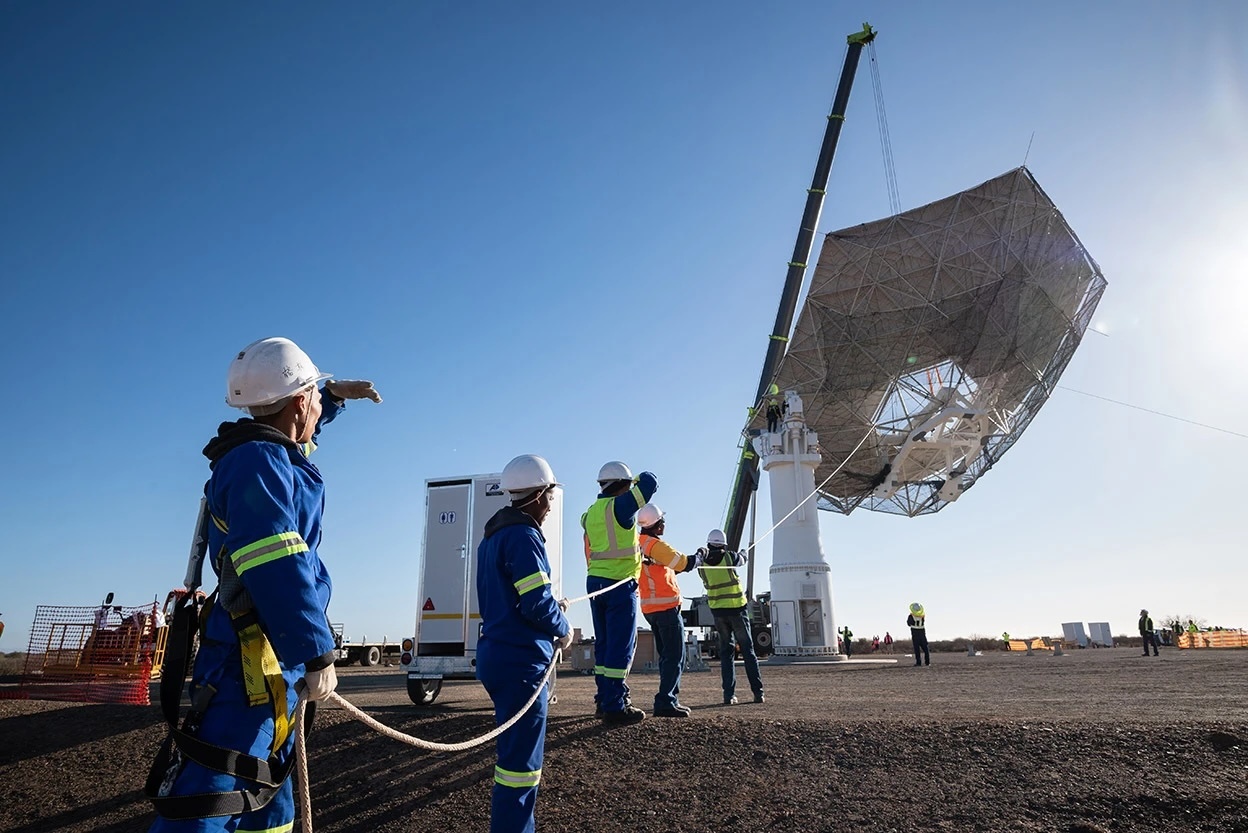29.09.2024
The Square Kilometre Array will take longer to expand further into eight African nations than originally planned.

The big lift: Engineers in South Africa participate as a crane lifts an SKA telescope reflector onto its pedestal (pictured in July). Credit: SKAO (CC BY 3.0)
The world’s largest telescope, the Square Kilometre Array (SKA), which is based in Australia and South Africa, is changing its plans and will not be expanding into eight African countries on its original timetable.
In August, SKA director-general Philip Diamond said in a briefing at the International Astronomical Union’s general assembly in Cape Town, that the observatory’s plans had “evolved”. The project will be unable to fund a large expansion into other countries on the original timescale that had been agreed on when the project's main sites were selected in 2012.
Diamond told Nature that “the ability to go from the current funding to another large monolithic phase of the project is probably just impractical. What we’re looking at now is much more of a phased, continual deployment.”
Pontsho Maruping, managing director of the South African Radio Astronomy Observatory (SARAO) in Cape Town, says that this will not affect the scientific scope of the project, but that the timing of its goals will depend on the availability of funding. “As soon as more funding is committed, more infrastructure will be deployed, including remote stations,” she says.
Nature's news team contacted the African Astronomical Society, based in Cape Town, and the Ghana Space Science and Technology Institute in Accra, to ask whether the changes would lead to a loss in research capacity in some African nations. They referred enquiries to the SARAO and the SKA Observatory global headquarters (SKAO), near Manchester, UK.
Whether the telescope will ever reach its target 'square kilometre' is not clear. Diamond said that it will not happen during his tenure as director-general. “It’s for future leaders to take us there.”
First images
SKA telescopes are interferometers, in which multiple dishes or antennas act as a single telescope. Together, they collect radio signals emitted by celestial objects. Astronomers hope that the array will shed light on some of the most enigmatic problems in astronomy, such as how galaxies form, the nature of dark matter and whether there is life on other planets.
So far, the SKAO has secured €2.1 billion (US$2.3 billion) from its ten official members: Australia, Canada, China, Italy, the Netherlands, Portugal, South Africa, Spain, Switzerland and the United Kingdom.
This funding covers the first ten years of the telescope’s construction and operation (2021–30), accounting for roughly 10% of the planned dishes and antennas. This includes 197 three-storey mid-frequency dishes in South Africa and 131,072 low-frequency antennas in western Australia, grouped into smaller arrays. Both telescopes — called SKA-Mid and SKA-Low — have produced their first images.
A second phase, with a starting date of 2020, was meant to comprise around 2,000 radio dishes in Botswana, Ghana, Kenya, Madagascar, Mauritius, Mozambique, Namibia and Zambia, along with South Africa, and a total of one million antennas in Australia. The total collecting area would be around one square kilometre, hence the name.
Enter Botswana
Maruping says that the SKAO’s decision to delay the second phase “does not stop us partnering with African partner countries and SKA members to deliver astronomy infrastructure as appropriate”.
For example, next year, Botswana, one of the eight partner countries, will get its first SKA dish through a collaboration with South Africa and Germany, with a funding arrangement outside of the initial SKA plan.
“It’s a game-changer for the science in Botswana,” says Kgomotso Thelo, a project manager at the Botswana International University of Science and Technology (BIUST) in Palapye. “We’ll begin to have those astronomers working on the data that's generated from their own telescope.”
The Max Planck Institute for Radio Astronomy in Bonn, Germany, and the German Center for Astrophysics in Görlitz are contributing the dish hardware, costing about €6 million. Meanwhile, Botswana is providing local support and covering infrastructure costs and South Africa is supplying other components, says Michael Kramer, an astronomer and director of the Max Planck Institute for Radio Astronomy.
The Max Planck Society, along with South Africa's government and the Astronomical Observatory of Capodimonte in Naples, Italy, are currently funding the addition of 14 dishes to South Africa’s 64-dish MeerKAT telescope, which will ultimately be incorporated into the SKA.
Similarly, the Botswana dish will also be incorporated into SKA. “The construction and operation of the dish will be the first significant astronomical facility to be sited in Botswana,” says Michael Bode, an emeritus professor of astrophysics at Liverpool John Moores University, UK.
Botswana has just a handful of professional astronomers, Thelo says. “It’s going to be a tough road ahead, but if you’ve got partners who have done it before, it makes it much easier for us,” he adds.
Quelle: nature
